Air Pollution and Menstrual Cycle Irregularities

Air Pollution and Menstrual Cycle Irregularities
Introduction
Air pollution, a pervasive environmental issue, has been linked to a multitude of health problems. Traditionally, discussions around air pollution have focused on respiratory and cardiovascular impacts. However, recent studies have started to uncover its broader implications, including its effects on reproductive health. One of the emerging areas of concern is the potential relationship between air pollution and menstrual cycle irregularities. Menstrual health is not just a matter of reproductive capability, but a crucial indicator of overall health. This article explores the complex interaction between air pollution and menstrual health, shedding light on recent research and potential mechanisms involved.
Understanding Menstrual Cycle Irregularities
What Constitutes a Normal Menstrual Cycle?
A typical menstrual cycle ranges from 21 to 35 days, with menstrual bleeding lasting between 3 to 7 days. However, "normal" can vary significantly among individuals. A regular cycle is generally a sign of hormonal balance and reproductive health.
Types of Menstrual Irregularities
Menstrual irregularities can manifest in various forms, including:
- Amenorrhea: Absence of menstruation for several months.
- Oligomenorrhea: Infrequent menstrual periods.
- Menorrhagia: Heavy and prolonged menstrual bleeding.
- Dysmenorrhea: Painful menstruation.
These irregularities can result from a variety of factors, including hormonal imbalances, stress, and lifestyle factors.
Air Pollution: An Overview
Sources and Types of Air Pollutants
Air pollution is the presence of harmful substances in the atmosphere. The major pollutants include:
- Particulate Matter (PM10 and PM2.5): Microscopic particles that can penetrate deep into the lungs.
- Nitrogen Dioxide (NO2): A gas from vehicles and industrial emissions.
- Sulfur Dioxide (SO2): Emitted from burning fossil fuels.
- Ozone (O3): A reactive gas formed from other pollutants.
- Volatile Organic Compounds (VOCs): Emitted from industrial processes and vehicle exhaust.
Health Impacts of Air Pollution
The impact of air pollution on health is well-documented. It is linked to:
- Respiratory diseases such as asthma and chronic obstructive pulmonary disease (COPD).
- Cardiovascular diseases such as heart attacks and strokes.
- Adverse pregnancy outcomes, including low birth weight and preterm birth.
The Link Between Air Pollution and Menstrual Cycle Irregularities
Recent Research Findings
Several studies have begun to explore the relationship between air pollution and menstrual health:
- Study in China (2018): Found that exposure to high levels of PM2.5 was associated with increased odds of menstrual irregularity among women.
- Research in the United States (2020): Suggested that long-term exposure to NO2 and PM10 was linked to a higher risk of irregular menstrual cycles.
- Study on Adolescents (2021): Indicated that adolescent girls exposed to high levels of air pollution experienced more irregular menstrual cycles compared to those in cleaner environments.
Biological Mechanisms
The mechanisms through which air pollution affects menstrual health are complex and multifaceted:
-
Hormonal Disruption: Pollutants may interfere with endocrine function, altering the release of hormones like estrogen and progesterone, crucial for regulating the menstrual cycle.
-
Inflammation: Air pollutants can induce systemic inflammation, which may disrupt the menstrual cycle by affecting the hypothalamus-pituitary-ovarian axis.
-
Oxidative Stress: Exposure to pollutants can lead to oxidative stress, damaging cells and tissues, potentially impacting the reproductive system.
-
Genetic and Epigenetic Changes: Some pollutants may cause genetic alterations or epigenetic changes that affect reproductive health.
Implications for Women's Health
Reproductive Health
Menstrual irregularities can have significant implications for reproductive health:
- Infertility: Irregular cycles can make it difficult to predict ovulation, complicating efforts to conceive.
- Pregnancy Complications: Women with irregular cycles may face more pregnancy-related complications.
Mental Health
Menstrual irregularities can also impact mental health:
- Stress and Anxiety: Unpredictable cycles can cause stress and anxiety, further exacerbating menstrual issues.
- Depression: Hormonal imbalances linked to cycle irregularities can contribute to mood disorders.
Broader Health Concerns
Menstrual health is a window into overall health:
- Metabolic Syndrome: Irregular cycles have been associated with metabolic syndrome, a cluster of conditions increasing the risk of heart disease, stroke, and diabetes.
- Bone Health: Hormonal imbalances affecting menstrual cycles can lead to decreased bone density, increasing the risk of osteoporosis.
Addressing the Issue
Policy and Regulation
To mitigate the impact of air pollution on health, stringent regulations are crucial:
- Emissions Control: Governments need to enforce stricter emissions standards for industries and vehicles.
- Air Quality Monitoring: Enhanced monitoring can help in taking timely action to reduce pollution levels.
- Public Awareness: Educating the public about the effects of air pollution and ways to minimize exposure is essential.
Personal Preventive Measures
Individuals can also take steps to protect themselves:
- Reduce Exposure: Limit time spent outdoors during high pollution days.
- Air Purifiers: Use air purifiers indoors to reduce indoor air pollution.
- Healthy Lifestyle: Maintain a balanced diet and regular exercise to help mitigate the effects of pollution.
Research and Future Directions
Further research is needed to fully understand the link between air pollution and menstrual health:
- Longitudinal Studies: More long-term studies are required to establish causal relationships.
- Mechanistic Studies: Research into the biological mechanisms can help in devising targeted interventions.
- Population Studies: Diverse population studies can help in understanding the varied impacts across different demographics.
Conclusion
The relationship between air pollution and menstrual cycle irregularities is an emerging area of concern that warrants attention. While the evidence is still evolving, the potential implications for women's health are significant. Addressing this issue requires a multi-faceted approach involving policy changes, public awareness, and further research. Understanding and mitigating the effects of air pollution on reproductive health is not only crucial for individual well-being but also for public health at large. As we continue to uncover the hidden impacts of air pollution, it becomes increasingly clear that clean air is not just an environmental necessity, but a fundamental component of health and quality of life.